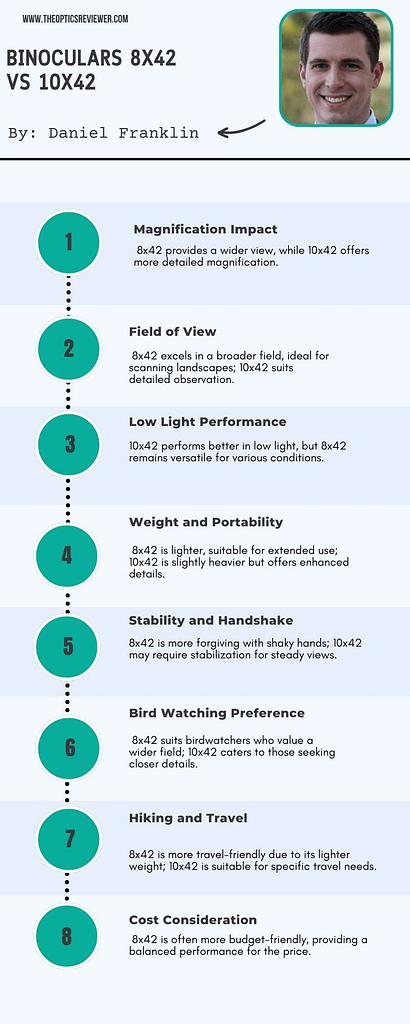Binoculars are the optical wonders that enlarge distant views and provide you with an outstanding viewing experience. The variants most commonly used when it comes to binoculars are 8×42 and 10×42. But which is a better option? Just because the 10×42 variant provides a higher magnification, should we gravitate towards it?
If you are also struggling to find the answers to these questions, then you are at the right place as we are pitting binoculars 8×42 vs 10×42. We will look into each nook and cranny, which would help you choose the unit that suits you best.
Contents
- 1 Key Highlights
- 2 Binoculars 8×42 vs 10×42: Which is Better?
- 3 Binoculars 8×42 vs 10×42 Evaluation Parameters
- 4 Highlights of Binoculars 8×42 vs 10×42
- 5 Final Verdict
- 6 References
- 7 FAQs
Key Highlights
- Consider whether 8x or 10x magnification suits your observation needs best.
- 8×42 provides a wider field of view, while 10×42 offers more detailed observation.
- 8×42 tends to be more stable and forgiving of hand movements.
- 8×42 binoculars are often lighter, enhancing portability compared to 10×42.
Binoculars 8×42 vs 10×42: Which is Better?
When choosing between binoculars, one crucial decision is the magnification factor. Magnification determines how much closer objects appear when viewed through the binoculars. In this comparison, we’ll explore the differences between 8×42 and 10×42 binoculars to help you decide which is better suited for your needs.
| Feature | 8×42 Binoculars | 10×42 Binoculars |
|---|---|---|
| Magnification | Objects appear 8 times closer than they are. | Objects appear 10 times closer than they are. |
| Field of View | Typically have a wider field of view. | Generally have a narrower field of view. |
| Stability | Provide more stable images due to lower magnification. | Slightly more prone to image shake due to higher magnification. |
| Low Light Performance | Better in low light conditions due to larger exit pupil. | Slightly inferior in low light due to smaller exit pupil. |
| Detail | Offers slightly less detailed images compared to 10×42. | Provides slightly more detailed images at long distances. |
In summary, 8×42 binoculars offer a wider field of view and better stability, making them ideal for activities like birdwatching or observing fast-moving subjects. On the other hand, 10×42 binoculars provide greater magnification and slightly better detail at longer distances, suitable for activities like stargazing or wildlife observation from a distance. Your choice depends on your specific needs and preferences.

Binoculars 8×42 vs 10×42 Evaluation Parameters
So we are going for a detailed analysis of binoculars 8×42 vs 10×42. Following are the parameters based on which we are going to compare and contrast these binoculars.
- Performance
- Weight and size
- Durability
- Price
- Purpose of use

Performance
So before we start with our main topic, firstly ask a question from yourself, “Why do we buy a pair of binoculars in the first place?” Clearly, we get them to get the most out of the view and augment the beauty and clarity of the far-flung action, Right?
Therefore a pair of binoculars should provide us with optical quality and optical precision. So we will take a good look at different optical elements and features that add to the binoculars’ performance to grasp the real essence of the contest between binoculars 8×42 vs 10×42.
Magnification
Magnification of the binoculars is the degree to which a pair of binoculars enlarges the reality for you. Most specialists agree that the optimum magnification for a pair of binoculars lies somewhere between 7X and 10x, depending on the particular purpose you want to use binoculars.
The first number inscribed or printed on the body of any pair of binoculars denotes the number of times the optical device enlarges your desired sight of view. In the case of the binoculars 8×42 vs 10×42, the former has a magnification of 8x, which means that it brings the distant world eight times closer to your eyes while it’s 10x in the latter, implying that 10×42 binoculars offer more magnification. But we still have to see if the higher magnification proves to be a merit or would it be a demerit for it. So let’s figure that out!
Higher magnification means that you can see the detailed view of a far-off object that puts the 10×42 binoculars on a higher spot than their 8×42 counterparts.
But it is also worth mentioning that the higher magnification often comes with the problem of image shakiness. Mostly this unsteadiness or distortion is seen in binoculars offering a magnification larger than 12X. So if you have steady hands, both the 8×42 and 10×42 binoculars would work fine for you. But if your hands are a bit shaky or you are on a shaking vessel, then with the binoculars of 10x magnification, there are chances for you to encounter image shakiness problems. So 8×42 binoculars seem to be a safe and better option in this scenario.
Field of View
The field of view represents the total area or the horizontal width of the view you can grasp with a pair of binoculars without the movement of your head. It is expressed with a particular number written alongside the feet per yards or degree sign, with the number and the degree sign accounting for the angular field of view. In the case of the field of view, the wider, the better rule sets in as with a broader field of view, you would be able to spot the thing you want to focus on instantly, and it would ensure that you won’t miss out on any crucial moments or once in a lifetime experience.
So we will also contrast the binoculars 8×42 vs 10×42 based on FOV. In optics, it is a well-known fact that with higher magnification, the field of view narrows down. A balance between the field of view and the magnification should be considered to catch the view’s very essence.
As the 10×42 binoculars offered more magnification than the 8×42, it implies the former will have a narrower field of view than the latter one. For instance, in Nikon Monarch binoculars, their 8×42 variant provides a field of view of 330 feet at 1000 yards while it is 288 feet at 1000 yards in the case of the 10×42 variant.
Hence, if you are in a stadium, watching your favorite sporting event, then by using 10×42 binoculars, there are chances that you will miss the bigger picture of the view. So the 8×42 binoculars would prove to be the best binoculars for sports because of their wider field of view.
Objective Lens
The second number written on the body of the binoculars represents the effective lens diameter. It shows the size of the aperture, which controls the amount of light that is transmitted. Hence the larger the lens diameter is, the more is the amount of light it transmits, and the brighter is the view you would get. It also impacts color reproduction and color fidelity.
While talking specifically about the binoculars, 8×42 vs 10×42, both binoculars come equipped with an objective lens of 42 mm that provides good light gathering ability and ensures a bright image with life-like colors from sunrise to sundown.
Last but not least, the thickness of the lens has a direct relation with the magnification. Thus higher magnification means a thicker lens, which reduces the amount of transmitted light. Both of the units have a minimal difference in the lens’s thickness, but this variance can become noticeable in low light conditions.
Exit Pupil
The objective lens diameter isn’t the only thing that controls the brightness and sharpness of the view in a multitude of lighting conditions. There is also an exit pupil number that dramatically influences the low light performance of a pair of binoculars.
The exit pupil is the width of the rays of light, leaving the eyepiece of the binoculars. It is a virtual aperture in an optical gadget and is the small bright circle that can be seen in the eyepiece’s center. The higher the exit pupil number is, the brighter will be the image you will get. So the best low light binoculars are the ones offering an exit pupil of 5 mm or higher.
So let’s calculate the exit pupil number to settle the dispute of binoculars 8×42 vs 10×42. To find out the exit pupil number, we have to divide the objective lens’s diameter by the magnification.
So in the case of 8×42 binoculars, the exit pupil is 42/8 = 5.25 mm, while it is 42/10 = 4.2 mm in 10×42 binoculars.
As in broad daylight, an exit pupil of more than 2 mm works decently, so both the 8×42 and 10×42 binoculars can perform well in the bright sunshine.
But as far as the low light performance of binoculars is concerned, as it directly depends upon the size of the exit pupil; therefore, in this category, 8×42 binoculars have the upper hand over the 10×42 binoculars.
Eye Relief
Eye relief is the optimum distance between your eyes and the eyepiece of the binoculars. You would be able to grasp the whole essence of the picture only if your eyes are within this distance. Eye relief is an essential factor when it comes to the binoculars for people with glasses, but it does not mean that you can’t use those binoculars if you don’t wear spectacles. You can still use the binoculars quite well and have a great view of your target with a unit offering a generous eye relief; thus, it is also a parameter worth stating in binoculars 8×42 vs 10×42.
The magnification has an inverse relation with eye relief. That means that the pair of binoculars having higher magnification will have comparatively shorter eye relief. Thus 8×42 binoculars having lower magnification than the 10×42 have longer eye relief.
For example, in Vortex diamondback 8×42 binoculars, the eye relief is 18 mm, while it is 16 mm in Vortex Diamondback 10×42 binoculars.
Weight and Size
Size and weight of a binocular play a significant role as there is a lot of demand for compact and lightweight options that can easily be used when you are out camping, hiking, biking, or hunting. It points out the need for light-weight, compact binoculars so that you will be more poised to move it from one place to another.
The objective lens diameter is the one that affects the weight of the binoculars the most. Both variants have the same effective lens diameter; therefore, this effect is nullified in combat of binoculars 8×42 vs 10×42.
But the thicker lens in the 10x variant makes it a bit heavier and larger than its 8x counterpart.
Durability
What’s the point of buying a pair of binoculars that can’t even survive a few falls or can’t handle a drizzle or rain? So we will also have a quick rundown of binoculars 8×42 vs 10×42 on the basis of durability.
Waterproofing
When you are out on the field to watch your favorite sporting event or your favorite artist’s concert, you can’t always predict the weather. So you as well as your optical gadget should always be ready for any unpredictable change in weather.
Hence your binoculars should provide you with features like waterproofing, fog-resistance, scratch-resistance, dust proofing, etc. so that you won’t have to worry about the view’s haziness in a humid environment or the accidental water splashing on your pair of binoculars. If we talk about precisely the binoculars 8×42 vs 10×42 based on waterproofing, both variants can or can’t have these features depending upon the product’s makers.
Rubber Armoring
Chassis is the housing or the framework that holds all the individual parts together in a unit. Different materials can be used to form barrels or chassis like polycarbonate plastic, magnesium, and aluminum. Moreover, the body of binoculars is also covered with rubber armoring in most of the cases, which adds an extra layer of protection.
The material used for chassis and rubber armoring depends solely on the manufacturers and the binoculars’ particular price range. It doesn’t have anything to do in particulars with 8x 0r 10x magnification.
Price
We are pitting binoculars 8×42 vs 10×42 for you. So when it comes to price, honestly speaking, every one of us wants a pair of binoculars that provide an excellent viewing experience without breaking our bank. We are spending our hard-earned money, and it is just natural to want a bang for your buck.
Both the 8×42 and 10×42 variants fall into the category of mid-priced binoculars that won’t put a hole in your wallet. They care about your budget and won’t lighten your wallet. But if we have to compare and contrast, then the variants with 10x magnification are pricier than the 8x variants. So if you are an outdoor enthusiast who wants a reasonably priced option for your next outdoor pursuit, you should surely opt for diamondback binoculars.
Purpose of Use
No doubt, all the features discussed above have their importance, but at the same time, we can’t forget to have a comparison of binoculars 8×42 vs 10×42 on the basis of event-specific features. So we will take a closer look at the variants to find out which one would serve better in which outdoor pursuit.
- Birdwatching: As birdwatching requires you to have a wider field of view so that you will quickly and easily catch the sight of a rare bird. So 8×42 binoculars are preferred in birding.
- Rifle Hunting: While hunting the deer in lush green meadows or dense forests require you to have an enlarged view of the far-flung targets; therefore, 10×42 binoculars will come in handy.
- Watching Sports: While watching your favorite football match, you need to have a bigger picture in a small frame, ensuring that you won’t miss any crucial moment of the match. So the 8×42 unit is the best binoculars for sports.
- Stargazing: Stars are far away from us; therefore, for stargazing, the optical device having higher magnification will be preferred because of its ability to provide a detailed view. Hence, 10×42 binoculars serve this purpose better.
Highlights of Binoculars 8×42 vs 10×42
It’s time to summarize our whole discussion to pinpoint the perks and shortcomings that both bring to the table that will help us ultimately reach a conclusion on the subject of binoculars 8×42 vs 10×42.
8×42 Binoculars
Below is a quick overview of 8×42 binoculars.
10×42 Binoculars
The precis of 10×42 binoculars are given below.
Final Verdict
To cut a long story short, which unit will be crowned as the winner in the battle of binoculars 8×42 vs 10×42 solely depends upon for what purpose you want these binoculars for? If, on the one hand, more steadiness to the image and wider field of view gives an upper hand to 8×42 binoculars, on the other hand, a more detailed view of far-off objects is a strong point of 10×42 binoculars.
Let’s settle it this way, for open field glassing and stargazing, 10×42 binoculars would be a better option. While in case of hiking, birding, watching sports, concerts, and other outdoor pursuits requiring a wide field of view, do not forget to keep a pair of 8×42 binoculars with you.
We hope that after reading this detailed combat of binoculars 8 x 42 vs 10 x 42, you will exactly know which size will be the best fit for your particular outdoor pursuit.
References
- https://link.springer.com/article/10.1007/BF00235723
- https://apps.dtic.mil/sti/citations/AD0895151
- https://www.sciencedirect.com/science/article/pii/B9780124437609500076
- https://www.cell.com/neuron/pdf/S0896-6273(21)00158-6.pdf
FAQs
Q. Which is Better, 8X42 or 10X42 Binoculars?
Choosing between 8×42 and 10×42 binoculars depends on your priorities. While 10×42 offers greater magnification, 8×42 provides a wider field of view and better low-light performance due to its higher exit pupil value. Consider your specific use and preferences before deciding.
Q. Which is Better, 10X50 or 10X42 Binoculars?
Ans: Both 10X50 and 10X42 binoculars magnify the distant objects ten times. The main difference between both of them is the diameter of their objective lens with 10X50 binoculars having a larger objective lens.
The objective lens is the one responsible for the brightness of the view. The larger the lens diameter is, the more is the amount of light it transmits, and the brighter is the view you would get. Thus, there is a potential that you will get brighter and better quality views through 10X50 binoculars.
Q. How to Choose The Appropriate Magnification of The Binoculars?
Binocular magnification, indicated by the first number in a specification like 10×42, determines how much closer the object appears. Optimal magnification typically falls between 7X and 10X, with 7X suitable for marine use and 10X or higher recommended for astronomy. It’s crucial to balance magnification, as higher values narrow the field of view, potentially limiting the overall scene captured.
Q. Is 8x or 10x Better For Bird Watching?
Choosing between 8x and 10x magnification for bird watching depends on personal preference. While 8x provides a wider field of view, 10x offers more detailed close-ups. Consider factors like stability and comfort for the best experience.
Q. What Size Binoculars are Best?
The best size for binoculars depends on the intended use. For general purposes like bird watching or sports events, compact 8×42 binoculars strike a good balance between magnification and portability. For more specialized activities like astronomy, larger 10×50 or 12×50 binoculars may be preferable for increased light-gathering ability.
Are 10×42 Binoculars Good For Bird Watching?
Yes, 10×42 binoculars are excellent for bird watching, offering a powerful 10x magnification and a 42mm objective lens for a clear and detailed view of distant birds. The combination of magnification and objective lens size provides a good balance for observing birds in various environments.

